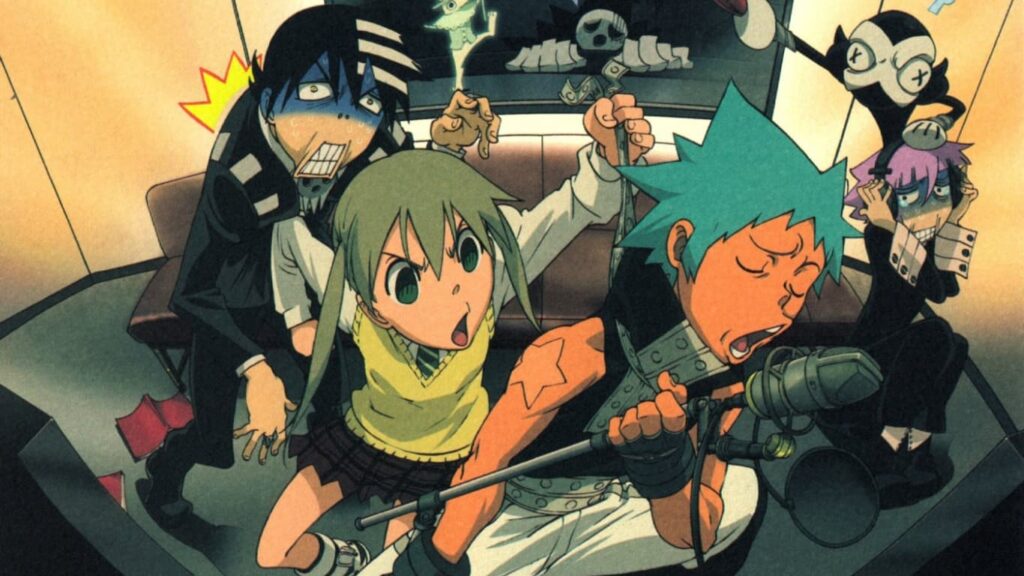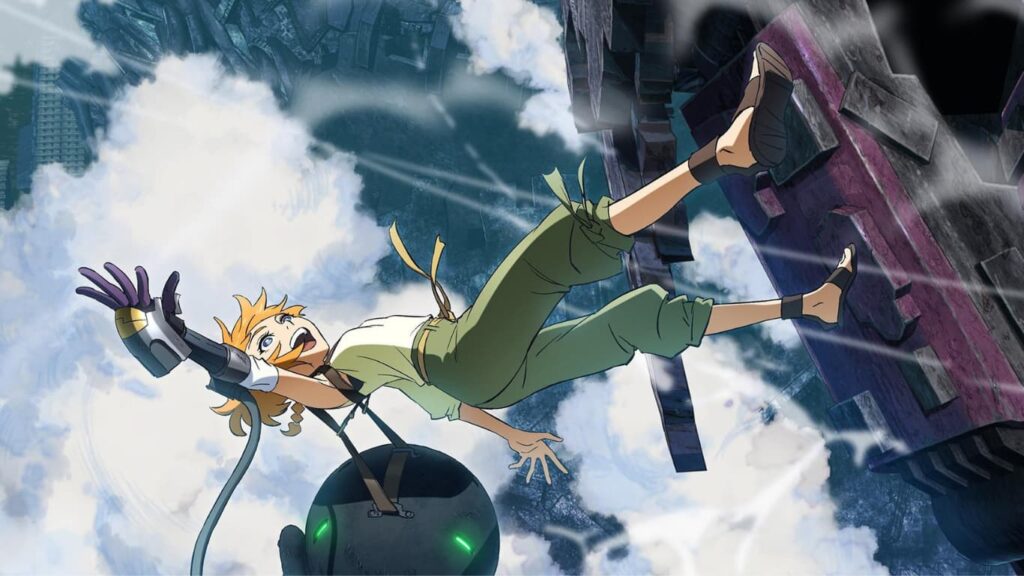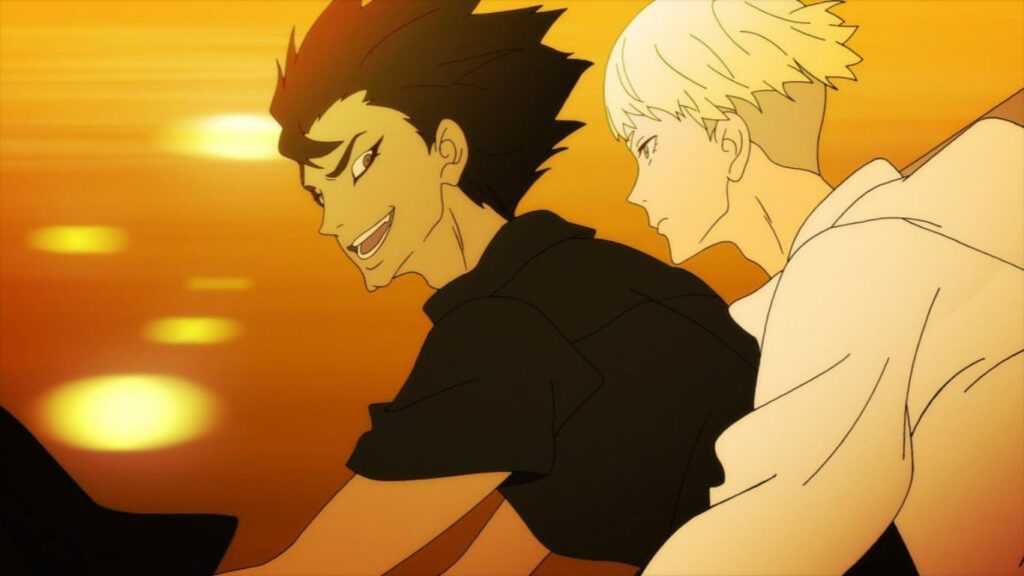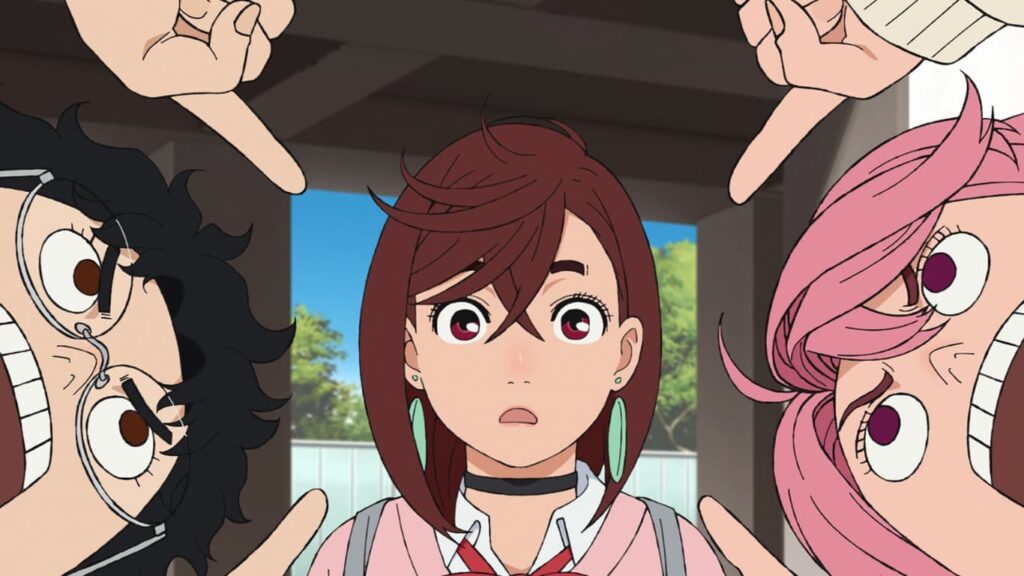If Gachiakuta pulled you in with its chaotic energy, raw worldbuilding, and rebellious protagonist, you’re not alone. Kei Urana’s breakout manga, known for its grungy aesthetic and brutal yet stylish fight scenes, has struck a chord with fans craving something fresh, wild, and just a little unhinged. It’s punk, it’s emotional, and it dares to be weird.
In fact, we’ve already talked about how hard Gachiakuta hits on the emotional and thematic front—this Gachiakuta quotes roundup is proof of how sharp its writing can be. And if you’ve ever had a moment where a single panel messed you up enough to start sketching at 2 AM, well… here’s my video of me doing exactly that with Rudo.
That’s the kind of impact Gachiakuta leaves—raw, restless, and hard to shake off. And once you’re caught up, still buzzing with that chaotic energy, the question naturally follows: what do you even watch next?
In this blog, we’re diving into anime that echo the same vibe—be it through post-apocalyptic cities, unconventional powers, anti-hero leads, or stunning, experimental visuals. These aren’t your average shonen picks. From the explosive streets of Akudama Drive to the eerie, off-kilter sci-fi of Dandadan, every title here offers a piece of that Gachiakuta-style madness.
Whether you’re here for gritty aesthetics, dark themes, or straight-up chaos—we’ve got you covered.
Anime Recommendations for Gachiakuta Fans: Chaos, Underdogs, and Emotion
1. Soul Eater
Supernatural action with a side of comedy and unforgettable characters.
At first glance, Soul Eater might seem like a chaotic, goth-punk battle anime with its twisted moon, cartoonishly creepy reapers, and weaponized teenagers. But under that stylized, almost pop-art exterior lies a deeper emotional core—one that resonates powerfully with Gachiakuta fans.
And that connection isn’t just thematic—it’s personal. Gachiakuta‘s creator, Kei Urana, once worked as an assistant to Soul Eater‘s author, Atsushi Ohkubo. In fact, when Gachiakuta‘s first volume dropped, Ohkubo himself drew Rudo and praised the manga, saying, “My rightful successor!!”
Like Gachiakuta, Soul Eater explores what it means to be broken, misunderstood, or “thrown away”—yet still rise again. In both worlds, characters wrestle with inner demons as much as physical enemies. Power comes with the risk of madness. Strength is forged not through isolation, but through connection—resonance of souls in one, shared humanity in the other.
Weapons in Soul Eater are literally people—mirroring the emotional burden of fighting alongside someone who reflects your deepest fears. And like Rudo, the cast is far from perfect. They doubt, break down, lash out—yet grow by confronting what’s within.
If Gachiakuta is a story of rising from the trash heap, Soul Eater is a story of holding onto your humanity in a world dancing with death. Both feel like battle cries from the fringes—raw, unpolished, and unafraid to dig deep.

2. Deca-Dence
A sci-fi adventure that flips the script on what it means to be human.
Deca-Dence is the kind of anime that starts off feeling familiar—a post-apocalyptic world, towering walls, and a society under siege from monstrous creatures called Gadoll. But just when you think you’ve seen it all before, it pulls the rug out from under you.
This isn’t just a survival story. It’s a bold commentary on control, rebellion, and identity.
Much like Gachiakuta, Deca-Dence places its outcast protagonist—Natsume—into a system designed to reject her. Both she and Rudo are “discarded” by society in different ways, yet both fight to carve their own meaning in a world that’s already written them off. Their journeys are about regaining agency, questioning authority, and refusing to be defined by the labels slapped on them.
Visually, Deca-Dence balances gritty dystopia with bursts of stylized color and strange sci-fi tech. There’s a chaotic charm in how it fuses its seemingly incompatible aesthetics—just like how Gachiakuta blends junkyard grime with high-octane action and emotion.
But what really makes Deca-Dence click for Gachiakuta fans is the layered storytelling. Underneath the battles and twisty worldbuilding is a deeply human narrative about resistance and self-worth. It asks not just how to survive—but what it means to truly live in a world that treats people like disposable parts.
If you’re drawn to rebellion stories with strange aesthetics, huge emotional payoffs, and protagonists who refuse to stay broken, Deca-Dence belongs high on your list.

3. Chainsaw Man
Dark, gritty, and unapologetically brutal—a must for fans of horror-tinged fantasy.
While Chainsaw Man and Gachiakuta may not share a direct lineage, fans often feel an unmistakable kinship between the two—and it’s easy to see why. Both belong to a new wave of shonen that dares to mix extremeness with poignancy, combining raw violence with moments of emotional vulnerability.
Tatsuki Fujimoto’s Chainsaw Man is known for its chaotic pacing, sudden deaths, and devastating emotional cuts—tools that Gachiakuta also wields in its own way. Whether it’s a character being ripped from the narrative unexpectedly or the world itself operating on logic that defies moral safety nets, both stories keep you on edge. In these worlds, survival trumps ethics.
Denji and Rudo may look like polar opposites, but they share a rare quality: their motivations are deeply personal, even selfish. Denji fights for a “normal life” filled with comfort and basic human needs, while Rudo searches for his own worth in a society that’s branded him trash. Neither of them fights for justice—but they fight hard nonetheless. And that’s what makes them human.
Both Chainsaw Man and Gachiakuta also explore desolate, broken worlds where “normal” no longer exists, and characters are forced to protect whatever scraps of belief or hope they have left. But where Chainsaw Man tears through its narrative with chaotic, almost absurd freedom, Gachiakuta is more grounded—focused on a slower, tenacious fight against systemic decay.
What ties these two creators together, even without a personal connection, is a modern storytelling ethos—one that doesn’t force righteousness on the reader. They let characters be flawed, confused, raw. And somehow, that honesty hits harder than any punch.
If you’re already a Fujimoto fan, this complete list of his manga is worth checking out. And if you’re here for the emotional chaos, you’ll want to dive into our favorite Chainsaw Man quotes—because sometimes the blood isn’t what leaves the biggest stain.
4. Devilman Crybaby
A visceral, emotional rollercoaster that redefines horror and drama.
If Gachiakuta feels like a slow burn uprising from the trash heap, Devilman Crybaby is a full-blown emotional detonation. Masaaki Yuasa’s reimagining of Go Nagai’s classic manga is brutal, beautiful, and deeply disturbing—a sensory and psychological gut-punch that Gachiakuta fans won’t soon forget.
Much like Gachiakuta, this is a story about outcasts, monsters, and the fragile line between humanity and inhumanity. Both Rudo and Akira Fudo are characters caught between worlds—rejected by society and forced to confront internal chaos as much as external violence. They’re protectors and destroyers all at once, clinging to connection in a world that punishes vulnerability.
Stylistically, Devilman Crybaby explodes with raw, surreal energy. It’s visual madness may feel different from Kei Urana’s detailed junkyard aesthetic, but the emotional weight hits just as hard—sometimes even harder. The violence isn’t just flashy; it’s purposeful, personal, and heartbreaking.
Thematically, this series dives deep into the same existential territory Gachiakuta hints at: what does it mean to fight when the world sees you as disposable? What happens when you try to hold onto your soul in a place that’s trying to rip it away?
If you’re into anime, that leaves a scar—and forces you to reflect on it—Devilman Crybaby is a must. And if psychological trauma and moral collapse are your thing (don’t worry, we won’t judge), don’t miss our list of must-watch psychological horror anime. Devilman Crybaby sits high on that throne for a reason.

5. Dorohedoro
A bizarre, hilarious, and violent dive into a world where magic and mayhem reign.
If Gachiakuta makes you love grime and chaos, Dorohedoro will make you breathe it in. This series takes the junkyard dystopia aesthetic to an entirely new level, throwing you headfirst into a decaying world full of sorcerers, mutants, talking lizards, and… surprise gyoza.
Like Gachiakuta, Dorohedoro thrives on contradiction. It’s grotesque but charming, violent yet weirdly cozy, filled with brutal battles and sudden tenderness. The world is broken in every possible way—physically, morally, magically—and yet it works, somehow. That chaotic beauty? It’s something both series share effortlessly.
The protagonist, Caiman, much like Rudo, is trying to find answers in a world that refuses to give them. He doesn’t fit anywhere, doesn’t know who he is, and is literally trying to kill his way toward the truth. Sound familiar? Both stories center on characters who have been fundamentally altered by the systems around them, cast aside, and yet never stop clawing toward purpose.
And let’s not forget the art styles. If you loved the hyper-detailed junk aesthetic of Gachiakuta, Dorohedoro will absolutely hit the spot. It’s raw, dirty, strange—and filled with an almost DIY energy that makes every scene feel alive. No wonder it earned a spot on our list of best experimental anime series—because no one does surreal worldbuilding quite like this.
More than anything, Dorohedoro excels in that same space Gachiakuta lives in: a world where survival isn’t clean or noble—it’s weird, painful, and maybe even funny sometimes. You’re not always sure what’s coming next, but you know it’ll be unforgettable.
6. Fire Force
A blazing mix of mystery and supernatural battles that’ll keep you hooked.
Fire Force is where supernatural firefighting meets explosive style—and its connection to Gachiakuta runs deeper than just vibes. As we have mentioned earlier, Kei Urana, creator of Gachiakuta, worked as an assistant under Fire Force’s author, Atsushi Ohkubo. That legacy is felt all over Gachiakuta—from its bold visual design to its chaotic, kinetic energy.
If Gachiakuta is the rebellion rising from a heap of trash, Fire Force is the flame that refuses to be put out. Both worlds are built on mystery, corruption, and characters who burn with more than just power—they burn with purpose. Shinra and Rudo are both treated as outcasts and viewed with suspicion, yet they push forward, refusing to be defined by the roles society has forced on them.
Stylistically, Fire Force and Gachiakuta share that signature Ohkubo flair: dramatic angles, sharp contrasts, surreal moments of levity, and beautifully chaotic action scenes. The characters feel electric—alive in a world that’s slowly collapsing around them.
More than just spectacle, Fire Force digs deep into the systems that create monsters, both literal and metaphorical. It questions religion, power structures, and what it really means to fight for humanity in a warped world. Much like Gachiakuta, it doesn’t shy away from showing the ugliness behind society’s polished exterior.
So if you’re looking for a series that combines emotional depth with explosive action—and if you want a deeper appreciation of the roots that helped Gachiakuta grow—Fire Force is essential viewing.
7. Dandadan
Where the supernatural meets laugh-out-loud comedy in a whirlwind of action.
At first glance, Dandadan might seem like the odd one out on this list. It’s loud, wild, and downright absurd at times—but beneath the alien invasions, ghost fights, and turbo-paced visuals lies a surprising amount of heart. And that’s where it connects deeply with Gachiakuta.
Created by Yukinobu Tatsu, a former assistant to Chainsaw Man‘s Tatsuki Fujimoto, Dandadan shares that new-generation shonen DNA: a fearless blend of extremes. It switches from hilarious to horrifying in seconds, much like how Gachiakuta balances explosive fight scenes with painful introspection and emotional trauma.
The protagonists of Dandadan—Okarun and Momo—may not come from the trash heap, but they still fight to prove their worth in a world that refuses to take them seriously. Like Rudo, they’re misfits, driven by personal pain, curiosity, and a need to connect with others who see them for who they are.
And let’s talk visuals. If you’re into Gachiakuta’s intense art style and dynamic movement, Dandadan will blow your mind. From kinetic panels to out-of-nowhere transformations, this series never takes its foot off the gas. It’s inventive, unapologetic, and totally unpredictable—just the kind of chaos Gachiakuta fans thrive on.
Both stories ask: how do you find your place in a world that refuses to understand you? The answers come through energy, empathy, and sheer momentum.

8. Hell’s Paradise: Jigokuraku
Dark fantasy meets historical action in a tale of survival and redemption.
If Gachiakuta made you fall in love with morally gray protagonists, brutal worldbuilding, and the idea that redemption comes with blood on your hands, Hell’s Paradise: Jigokuraku is your next stop.
Set in a twisted version of Edo-era Japan, this series follows Gabimaru the Hollow, a ninja sentenced to death who’s offered freedom if he can survive a mysterious, deadly island filled with demonic creatures and mind-breaking trials. Like Rudo, Gabimaru is labeled a criminal—but refuses to let that define him. His fight isn’t for glory—it’s for something deeply personal: to return to the one person who truly believed in him.
Thematically, Hell’s Paradise shares a lot with Gachiakuta. Both series challenge the idea of good and evil in broken systems. Both explore violence not as spectacle, but as consequence. And both feature characters who aren’t “heroes” in the traditional sense—but who fight like hell anyway, often for something as fragile and human as hope.
Visually, Hell’s Paradise is haunting and hypnotic—lush landscapes hide grotesque horrors, and the fight choreography is stunning in its brutality. If you were pulled into Gachiakuta by the sharp artwork and the emotional stakes of every battle, this anime will pull you even deeper into that beautifully ugly spiral.
And when the dialogue cuts deep, it stays with you. Check out our favorite quotes from Hell’s Paradise to revisit some of the most intense lines the series has to offer—words that hit just as hard as the blades.
In short, if you want an anime that makes you question who deserves to survive in a broken world, Hell’s Paradise delivers that moral punch right to the gut.
9. Akudama Drive
Cyberpunk thrills with a criminal twist that’s as stylish as it is intense.
If Gachiakuta thrives in the dirt and grime of a world that rejects its protagonist, Akudama Drive throws you into a slick, neon-lit dystopia where being an outlaw isn’t the exception—it’s the rule.
Set in a hyper-stylized, post-war Kansai, the series follows a group of criminals—each with a deadly specialty—as they’re forced together for a heist that spirals into chaos, rebellion, and tragedy. Like Rudo, the characters in Akudama Drive are branded by society as “trash,” and like Gachiakuta, the series questions who really deserves that label.
What makes Akudama Drive so striking is its unapologetic style and speed. The action is explosive, the direction is cinematic, and the pacing rarely lets you breathe. But underneath all the aesthetic cool is a sharp social commentary—one that mirrors Gachiakuta’s critique of class systems, corruption, and the illusion of justice.
You won’t find many “heroes” here. Just like Rudo, these characters are deeply flawed, constantly clashing with the roles forced on them. And yet, somehow, even the most violent Akudama can pull at your empathy when the mask starts to crack.
Both series ask the same question in different ways: If the world calls you disposable, do you accept it—or tear the whole thing down?
If you’re in the mood for criminal chaos, nihilistic undertones, and characters who spit in the face of a broken system, Akudama Drive is your next adrenaline fix.
10. Cyberpunk: Edgerunners
A neon-soaked, high-octane ride through a world of tech and rebellion.
Cyberpunk: Edgerunners isn’t just another dystopian anime—it’s a tragic, beautifully animated explosion of rebellion, loss, and defiance. And for Gachiakuta fans, it hits all the right nerves: a cruel system, a protagonist scraping to survive, and a final stand that feels as inevitable as it is heartbreaking.
David Martinez, much like Rudo, is a young man born into a world that sees him as worthless. Society chews him up, spits him out, and leaves him with one choice: either stay down or modify yourself beyond recognition and fight back. In both stories, the system is so stacked against the individual that survival itself becomes an act of resistance.
Visually, Edgerunners is a spectacle. Trigger’s animation style is electric—pulsing with neon rage, slow-motion heartbreak, and brutal elegance. While Gachiakuta leans into gritty junkyard grime, Edgerunners goes full chrome—and yet, both worlds feel equally hostile, equally alive, and equally unfair.
What makes Cyberpunk: Edgerunners especially powerful is its emotional center. It doesn’t just show violence; it shows why people end up there, why they break, why they keep going, why they fall. And just like Gachiakuta, it doesn’t hand you easy answers—only the messy, painful truth of people trying to matter in a world that wants to forget them.
If Gachiakuta is the scream of the outcast, Cyberpunk: Edgerunners is its echo in the future.
Final Thoughts: Beyond the Trash Heap
Gachiakuta may be raw, violent, and chaotic—but it’s also deeply human. It’s a story about finding worth in a world that deems you disposable. About broken people trying to rebuild themselves. And that emotional current—messy, painful, and defiant—is exactly what connects every anime on this list.
Whether it’s the stylish rebellion of Akudama Drive, the tragic flame of Fire Force, or the haunting beauty of Hell’s Paradise, each of these series offers more than just action. They’re about survival, about trauma, about what it means to keep fighting even when the world writes you off.
So if Gachiakuta left you craving more stories with grit, soul, and something a little unhinged—these anime are your next stop.
And hey, if you’re into Gachiakuta and all the beautifully broken stories like it, don’t forget to subscribe to us on YouTube or follow us on socials for more anime manga suggestions, cool shorts and reels, and sketch rants at 2 AM.



